人教版(2019)必修第三册Unit 3 Diverse Cultures Grammar and usage V-ing作状语和宾补课件 (共23张PPT)
文档属性
| 名称 | 人教版(2019)必修第三册Unit 3 Diverse Cultures Grammar and usage V-ing作状语和宾补课件 (共23张PPT) | 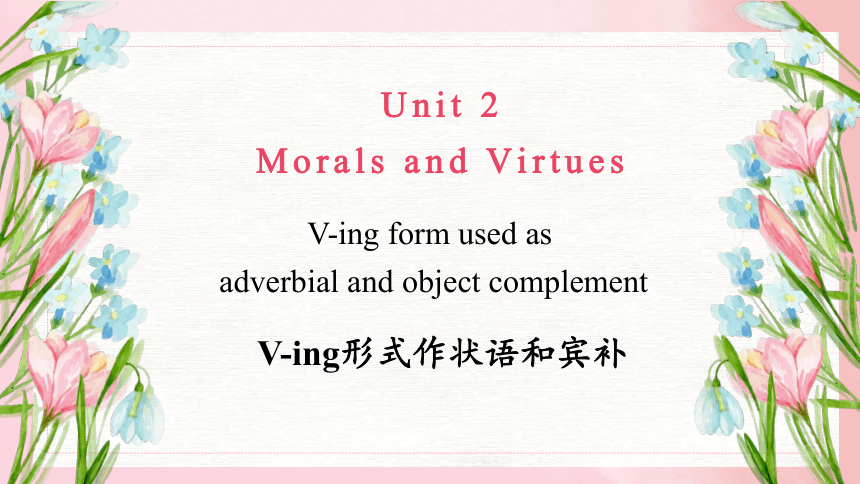 | |
| 格式 | pptx | ||
| 文件大小 | 3.6MB | ||
| 资源类型 | 教案 | ||
| 版本资源 | 人教版(2019) | ||
| 科目 | 英语 | ||
| 更新时间 | 2023-05-15 10:27:23 | ||
图片预览

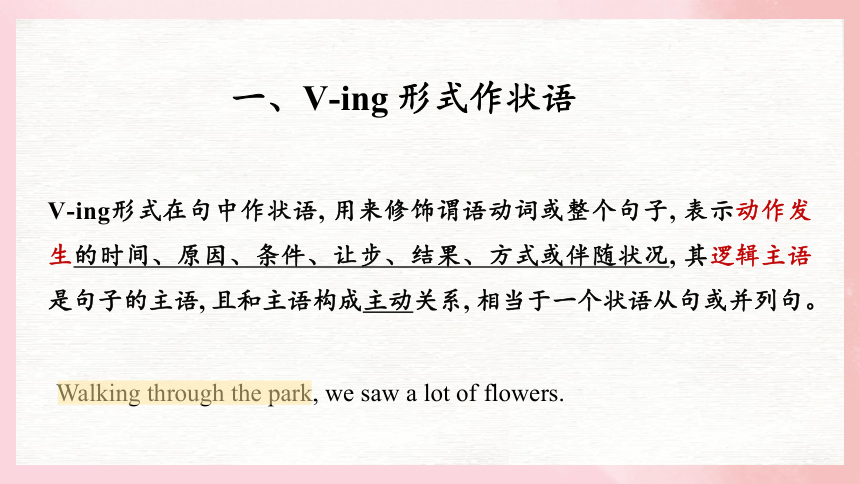
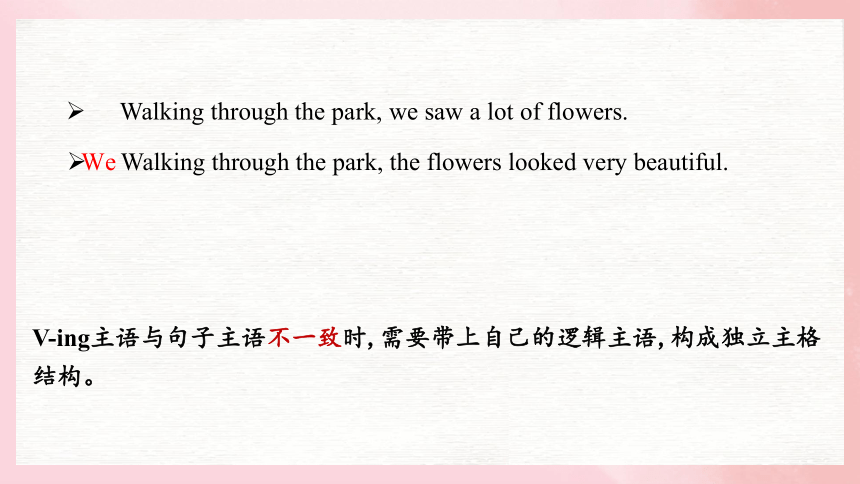
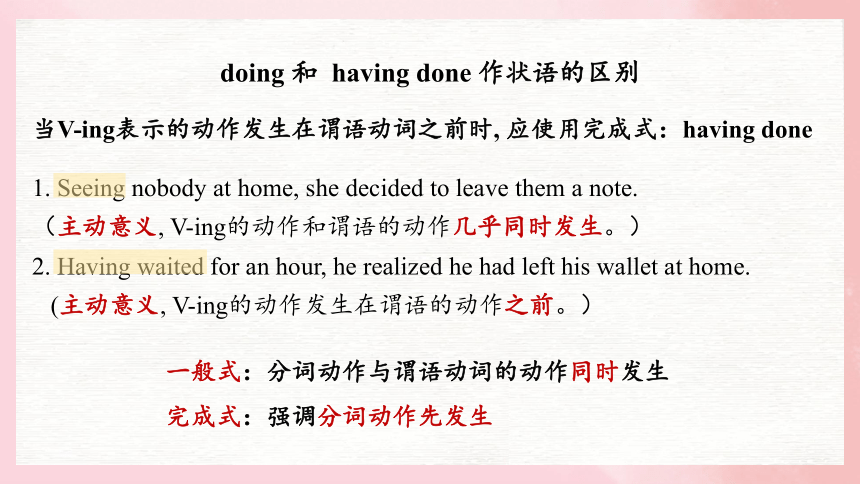
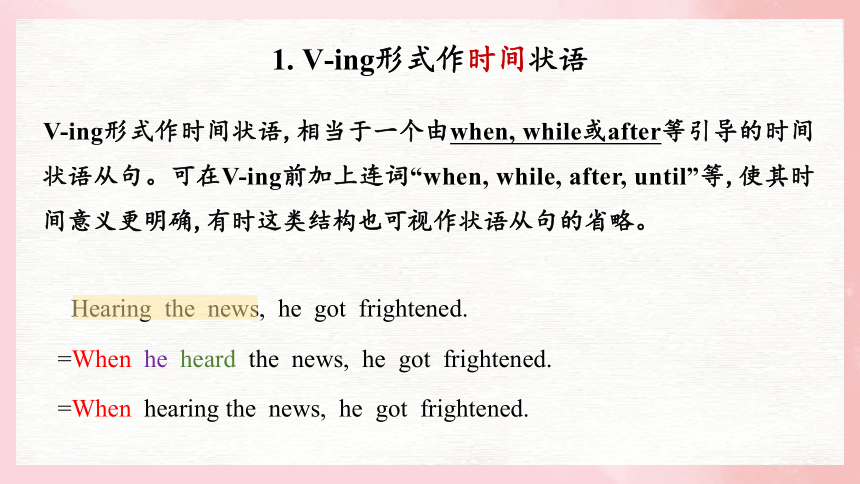
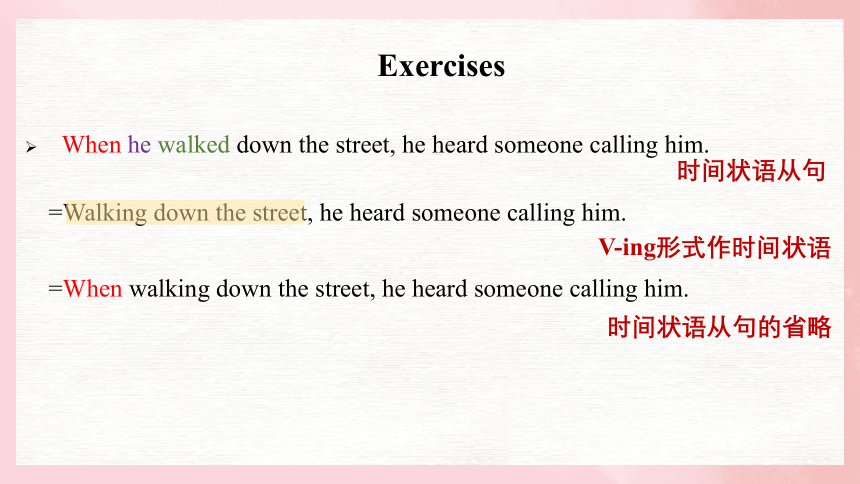
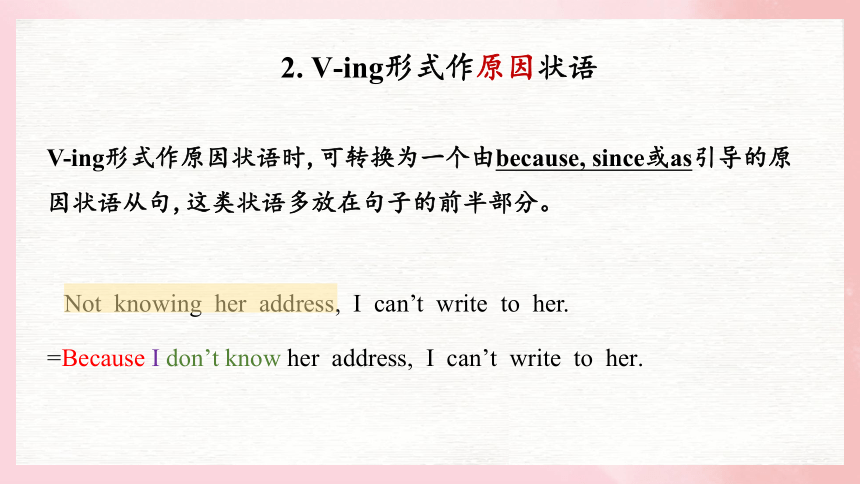
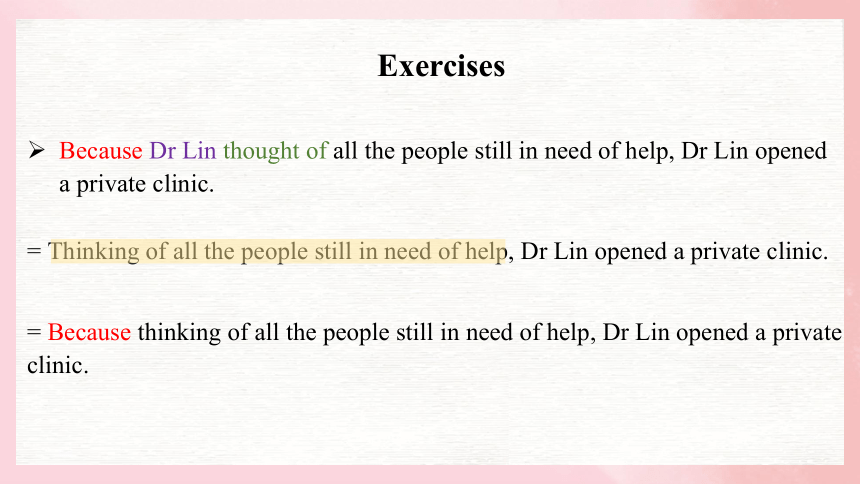
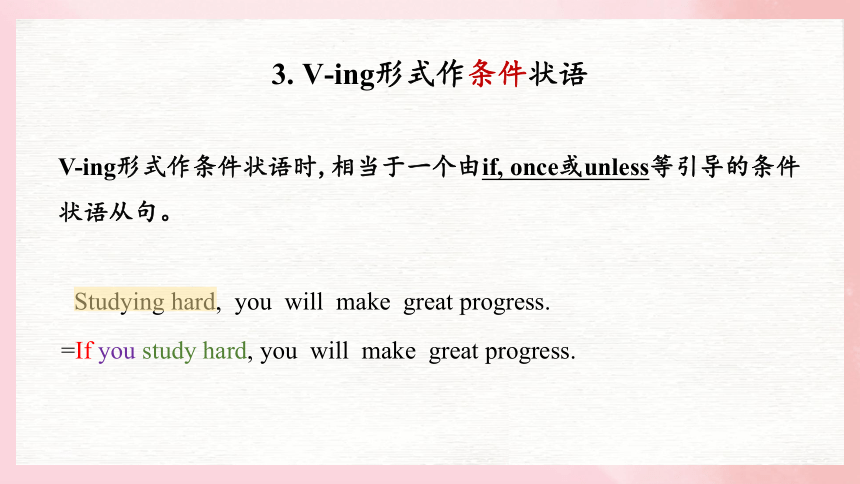
文档简介
(共23张PPT)
Unit 2
Morals and Virtues
V-ing form used as
adverbial and object complement
V-ing形式作状语和宾补
一、V-ing 形式作状语
V-ing形式在句中作状语, 用来修饰谓语动词或整个句子, 表示动作发生的时间、原因、条件、让步、结果、方式或伴随状况, 其逻辑主语是句子的主语, 且和主语构成主动关系, 相当于一个状语从句或并列句。
Walking through the park, we saw a lot of flowers.
Walking through the park, the flowers looked very beautiful.
V-ing主语与句子主语不一致时,需要带上自己的逻辑主语,构成独立主格结构。
We
Walking through the park, we saw a lot of flowers.
1. Seeing nobody at home, she decided to leave them a note.
(主动意义, V-ing的动作和谓语的动作几乎同时发生。)
2. Having waited for an hour, he realized he had left his wallet at home.
(主动意义, V-ing的动作发生在谓语的动作之前。)
一般式:分词动作与谓语动词的动作同时发生
完成式:强调分词动作先发生
doing 和 having done 作状语的区别
当V-ing表示的动作发生在谓语动词之前时, 应使用完成式:having done
V-ing形式作时间状语,相当于一个由when, while或after等引导的时间状语从句。可在V-ing前加上连词“when, while, after, until”等,使其时间意义更明确,有时这类结构也可视作状语从句的省略。
Hearing the news, he got frightened.
=When he heard the news, he got frightened.
1. V-ing形式作时间状语
=When hearing the news, he got frightened.
When he walked down the street, he heard someone calling him.
=When walking down the street, he heard someone calling him.
=Walking down the street, he heard someone calling him.
Exercises
时间状语从句
V-ing形式作时间状语
时间状语从句的省略
Not knowing her address, I can’t write to her.
=Because I don’t know her address, I can’t write to her.
2. V-ing形式作原因状语
V-ing形式作原因状语时,可转换为一个由because, since或as引导的原因状语从句,这类状语多放在句子的前半部分。
Because Dr Lin thought of all the people still in need of help, Dr Lin opened a private clinic.
= Because thinking of all the people still in need of help, Dr Lin opened a private clinic.
= Thinking of all the people still in need of help, Dr Lin opened a private clinic.
Exercises
Studying hard, you will make great progress.
=If you study hard, you will make great progress.
3. V-ing形式作条件状语
V-ing形式作条件状语时,相当于一个由if, once或unless等引导的条件状语从句。
If you turn to the right, you will find a path leading to his cottage.
= If turning to the right, you will find a path leading to his cottage.
= Turning to the right, you will find a path leading to his cottage.
Exercises
Living miles away, he attended the course.
=Although he lived miles away, he attended the course.
4. V-ing形式作让步状语
V-ing形式作让步状语时,相当于一个由though, although, even if或even though等引导的让步状语从句。
Nora stood at the bus stop, waiting for a bus.
= Nora stood at the bus stop and waited for a bus.
5. V-ing形式作方式、伴随状语
V-ing形式作方式或伴随状语时,一般情况下,V-ing所表示的动作和谓语动词所表示的动作同时发生。通常不能转换为状语从句,但可用并列句来转换。
The child fell off the tree, hitting his head against the ground.
=The child fell off the tree, and he hit his head against the ground.
6. V-ing形式作结果状语
V-ing形式作结果状语时,通常放在句末,中间有逗号,有时为了突出结果, V-ing前带有thus.
知识延伸: (doing 和to do作结果状语的区别)
① The COVID-19 broke out throughout the world, causing hundreds of thousands of deaths.
② I came to school last Sunday morning ,only to find nobody was in our
classroom.
doing 作结果状语时,常表示自然而然,情理之中的结果;
to do 作结果状语时,往往表示出乎意料的结果,通常与only连用。
generally speaking 一般来说
frankly speaking 坦率地说
personally speaking 就个人而言
according to 根据…
7. V-ing形式作评论性状语
有些惯用的V-ing短语并不表示句子主语的动作,在句中没有逻辑上的主语而独立存在,它们往往作为句子的独立成分来修饰全句,表明说话者的态度观点等。我们称这种状语为评论性状语或评注性状语。
1. Using your head, you’ll find a good way.
2. Being poor, he couldn’t afford a TV set.
3. Hearing the news, they all jumped with joy.
4. Admitting what she has said, I still think that she hasn’t tried her best.
5. Please answer the question using another way.
6. Four people entered the room looking around in a curious way.
7. He had a high fever when he was three, making him completely blind.
条件
结果
伴随
方式
让步
时间
原因
V-ing 作时间,原因,条件,让步等状语时,一般放在句首。
作方式,伴随,结果等状语时,一般放在句末。
V-ing 形式作宾语补足语, 置于某些及物动词和宾语之后,补充说明宾语的动作或状态,其逻辑主语是宾语,表示一个正在进行的主动性的动作。
二、V-ing 形式作宾语补足语
The boss kept the workers working the whole night.
V-ing形式在 see, watch, observe, look, notice, hear, feel 等感官动词(短语)后作宾语补足语, 构成复合宾语, 表示一个正在进行的主动的动作, 强调一个过程或一种状态。
see +宾语+ doing sth 看见···正在做某事
1. 感官动词+宾语+V-ing宾补
Today on my way home, I saw a man running along the street hurriedly.
I’m sorry to keep you waiting for so long.
2. 使役动词+宾语+V-ing宾补
V- ing形式在表示“使”“令”“让”等意义的使役动词后作宾语补足语,
如make, get, have, help, keep, leave,表示“让…一直做某事”。
With the time passing by, he almost forgot everything in the past.
3. with+宾语+V-ing宾补
在with复合结构中,如果宾语发出动作,且表示动作持续或进行,则用
V-ing作宾语补足语。
常见的带V-ing作宾补的词
感观动词
使役动词
with的复合结构
see/hear/watch/find/notice/feel + sb/sth + doing
have/get/make/leave/keep + sb/sth + doing
with + n./pron+doing
正在进行
一直做,一直处于某种状态
主动
V-ing形式
作宾补
作状语
______________________________________________________
时间状语
原因状语
结果状语
条件状语
让步状语
方式状语
伴随状语
在 后作宾补
在 后作宾补
在 后作宾补
感官动词
使役动词
with复合结构
评论性状语
THANKS
Unit 2
Morals and Virtues
V-ing form used as
adverbial and object complement
V-ing形式作状语和宾补
一、V-ing 形式作状语
V-ing形式在句中作状语, 用来修饰谓语动词或整个句子, 表示动作发生的时间、原因、条件、让步、结果、方式或伴随状况, 其逻辑主语是句子的主语, 且和主语构成主动关系, 相当于一个状语从句或并列句。
Walking through the park, we saw a lot of flowers.
Walking through the park, the flowers looked very beautiful.
V-ing主语与句子主语不一致时,需要带上自己的逻辑主语,构成独立主格结构。
We
Walking through the park, we saw a lot of flowers.
1. Seeing nobody at home, she decided to leave them a note.
(主动意义, V-ing的动作和谓语的动作几乎同时发生。)
2. Having waited for an hour, he realized he had left his wallet at home.
(主动意义, V-ing的动作发生在谓语的动作之前。)
一般式:分词动作与谓语动词的动作同时发生
完成式:强调分词动作先发生
doing 和 having done 作状语的区别
当V-ing表示的动作发生在谓语动词之前时, 应使用完成式:having done
V-ing形式作时间状语,相当于一个由when, while或after等引导的时间状语从句。可在V-ing前加上连词“when, while, after, until”等,使其时间意义更明确,有时这类结构也可视作状语从句的省略。
Hearing the news, he got frightened.
=When he heard the news, he got frightened.
1. V-ing形式作时间状语
=When hearing the news, he got frightened.
When he walked down the street, he heard someone calling him.
=When walking down the street, he heard someone calling him.
=Walking down the street, he heard someone calling him.
Exercises
时间状语从句
V-ing形式作时间状语
时间状语从句的省略
Not knowing her address, I can’t write to her.
=Because I don’t know her address, I can’t write to her.
2. V-ing形式作原因状语
V-ing形式作原因状语时,可转换为一个由because, since或as引导的原因状语从句,这类状语多放在句子的前半部分。
Because Dr Lin thought of all the people still in need of help, Dr Lin opened a private clinic.
= Because thinking of all the people still in need of help, Dr Lin opened a private clinic.
= Thinking of all the people still in need of help, Dr Lin opened a private clinic.
Exercises
Studying hard, you will make great progress.
=If you study hard, you will make great progress.
3. V-ing形式作条件状语
V-ing形式作条件状语时,相当于一个由if, once或unless等引导的条件状语从句。
If you turn to the right, you will find a path leading to his cottage.
= If turning to the right, you will find a path leading to his cottage.
= Turning to the right, you will find a path leading to his cottage.
Exercises
Living miles away, he attended the course.
=Although he lived miles away, he attended the course.
4. V-ing形式作让步状语
V-ing形式作让步状语时,相当于一个由though, although, even if或even though等引导的让步状语从句。
Nora stood at the bus stop, waiting for a bus.
= Nora stood at the bus stop and waited for a bus.
5. V-ing形式作方式、伴随状语
V-ing形式作方式或伴随状语时,一般情况下,V-ing所表示的动作和谓语动词所表示的动作同时发生。通常不能转换为状语从句,但可用并列句来转换。
The child fell off the tree, hitting his head against the ground.
=The child fell off the tree, and he hit his head against the ground.
6. V-ing形式作结果状语
V-ing形式作结果状语时,通常放在句末,中间有逗号,有时为了突出结果, V-ing前带有thus.
知识延伸: (doing 和to do作结果状语的区别)
① The COVID-19 broke out throughout the world, causing hundreds of thousands of deaths.
② I came to school last Sunday morning ,only to find nobody was in our
classroom.
doing 作结果状语时,常表示自然而然,情理之中的结果;
to do 作结果状语时,往往表示出乎意料的结果,通常与only连用。
generally speaking 一般来说
frankly speaking 坦率地说
personally speaking 就个人而言
according to 根据…
7. V-ing形式作评论性状语
有些惯用的V-ing短语并不表示句子主语的动作,在句中没有逻辑上的主语而独立存在,它们往往作为句子的独立成分来修饰全句,表明说话者的态度观点等。我们称这种状语为评论性状语或评注性状语。
1. Using your head, you’ll find a good way.
2. Being poor, he couldn’t afford a TV set.
3. Hearing the news, they all jumped with joy.
4. Admitting what she has said, I still think that she hasn’t tried her best.
5. Please answer the question using another way.
6. Four people entered the room looking around in a curious way.
7. He had a high fever when he was three, making him completely blind.
条件
结果
伴随
方式
让步
时间
原因
V-ing 作时间,原因,条件,让步等状语时,一般放在句首。
作方式,伴随,结果等状语时,一般放在句末。
V-ing 形式作宾语补足语, 置于某些及物动词和宾语之后,补充说明宾语的动作或状态,其逻辑主语是宾语,表示一个正在进行的主动性的动作。
二、V-ing 形式作宾语补足语
The boss kept the workers working the whole night.
V-ing形式在 see, watch, observe, look, notice, hear, feel 等感官动词(短语)后作宾语补足语, 构成复合宾语, 表示一个正在进行的主动的动作, 强调一个过程或一种状态。
see +宾语+ doing sth 看见···正在做某事
1. 感官动词+宾语+V-ing宾补
Today on my way home, I saw a man running along the street hurriedly.
I’m sorry to keep you waiting for so long.
2. 使役动词+宾语+V-ing宾补
V- ing形式在表示“使”“令”“让”等意义的使役动词后作宾语补足语,
如make, get, have, help, keep, leave,表示“让…一直做某事”。
With the time passing by, he almost forgot everything in the past.
3. with+宾语+V-ing宾补
在with复合结构中,如果宾语发出动作,且表示动作持续或进行,则用
V-ing作宾语补足语。
常见的带V-ing作宾补的词
感观动词
使役动词
with的复合结构
see/hear/watch/find/notice/feel + sb/sth + doing
have/get/make/leave/keep + sb/sth + doing
with + n./pron+doing
正在进行
一直做,一直处于某种状态
主动
V-ing形式
作宾补
作状语
______________________________________________________
时间状语
原因状语
结果状语
条件状语
让步状语
方式状语
伴随状语
在 后作宾补
在 后作宾补
在 后作宾补
感官动词
使役动词
with复合结构
评论性状语
THANKS
